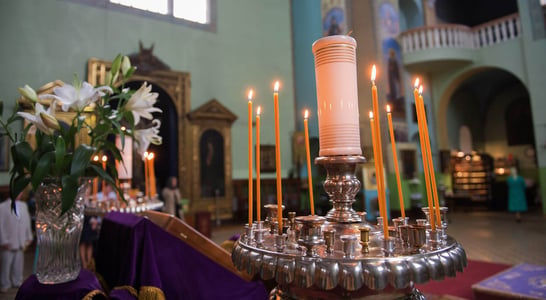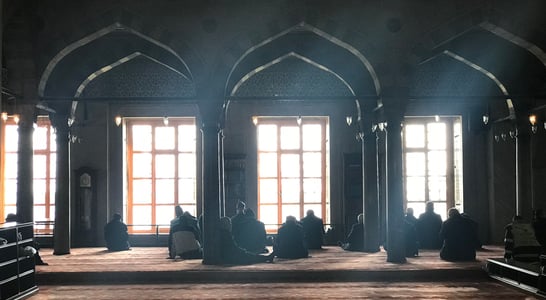
Advent Begins
Advent marks a period of eager anticipation and preparation for Christmas, which celebrates the birth of Jesus Christ.
Each year, Advent begins on the fourth Sunday before Christmas, which can fall anywhere between November 27 and December 3, ending on Christmas Eve, December 24.
This timing reminds us that the holiday season is about more than just festive decorations and gift-giving. It’s a time to prepare spiritually for the “coming” of Christ in various forms: his historical birth, his presence in the lives of believers today, and his future return.
The celebration of Advent is rich with symbolism and tradition. Among the most visible traditions is the Advent wreath, an evergreen circle with four candles.
Each candle is lit successively on each of the four Sundays leading up to Christmas. The candles represent significant themes of hope, faith, joy, and peace, each adding to the reflective nature of the season. This practice, which began in the 19th century, combines visual and thematic elements to deepen the spiritual experience of Christmas.
Why do we observe Advent? It’s a time dedicated to spiritual reflection and readiness, aligning our hearts and minds with the profound implications of Christmas.
The season fosters a sense of anticipation for Christ’s birth, encourages personal reflection, and promotes communal preparation through prayers, hymns, and readings. It’s a time when many engage in acts of kindness and charity, resonating with the themes of hope and renewal that are central to the period.
This preparatory phase not only enriches the celebration of Christmas but also strengthens the community and individual commitments to the teachings of Christ.
History of Advent Begins
The history of Advent is a fascinating journey through time, reflecting the evolving traditions and practices of Christian communities.
The term “Advent” originates from the Latin word “adventus,” meaning “coming,” which underscores the season’s focus on anticipation and preparation for both the celebration of Jesus Christ’s birth and his expected return.
Historically, Advent dates back to at least the fourth century. Early references suggest that by this time, Christians in Spain and Gaul observed a season of preparation for the Epiphany, not Christmas itself.
This early form of Advent was not primarily about celebrating Christ’s birth but rather focused on preparation for baptism and reflecting on Jesus’ second coming.
By the sixth century, practices related to Advent were more formalized within the church, involving fasting and penance.
This period was initially longer, similar to Lent, beginning right after St. Martin’s Day in November and lasting until Christmas. Over the centuries, the duration of Advent was shortened to the four weeks we observe today.
The focus of Advent shifted closer to Christmas during the Middle Ages, aligning more directly with preparing to celebrate Christ’s nativity. This transition marked a change from a penitential season to one of hopeful anticipation.
In modern times, Advent retains its dual character, looking back at Christ’s first coming while also anticipating his return.
Traditions such as the Advent wreath, introduced in the 19th century, and the lighting of its four candles symbolize themes of hope, peace, joy, and love, each contributing to the season’s reflective nature.
Today, Advent is celebrated with various customs that enrich the spiritual experience of believers, emphasizing reflection, community, and joyous anticipation of the Christmas celebration
How to Celebrate Advent Begins
Send a Little Joy
What’s more fun than opening mail? Get crafty and send homemade Christmas cards. As the cards pile up, pick one each day and send back some cheer with a prayer or a thank note.
Pray in Your Way
Who said prayers have to be solemn? Set up an evening routine of playful, expectant prayer. Sit quietly, no script needed, and let the stillness fill you up.
Get Creative with Calendars
Ditch the chocolate-filled Advent calendars! Create your own with treats, little gifts, or kind deeds tucked into each day. It’s a joyful way to count down to Christmas.
Give Back with a Box
Dive into some do-goodery! Pack up a shoebox with gifts and essentials for a child in need. This little box can light up someone’s world.
Carve Out Quiet Time
Remember, it’s okay to say “no.” Advent is the perfect time to enjoy peace and quiet. Choose to attend only the gatherings that really matter to you.
Nativity Know-How
Set up a nativity scene at home. It’s a great way to keep the true meaning of the season front and center and spark meaningful family discussions.
Sing Out
Warm up those vocal cords and spread some joy with caroling. Whether door-to-door or at a community event, singing lifts spirits and brings smiles.
Also on ...
View all holidaysNational Cookie Cutter Day
Transform your cookies with fun shapes and designs. Cookie cutters are a must-have tool for any baking enthusiast.
Play Basketball Day
The fast-paced game that echoes with the rhythmic bounce of the ball and the swish of the net, where teamwork reigns supreme.
Let’s Hug Day
Hugging can lower stress, boost happiness, and strengthen bonds. It’s a great way to show love and appreciation, and it feels amazing!
National Cookie Day
Bake some sugary, buttery and perfectly rounded snacks, indulge in classics like chocolate chip or experiment with unusual flavors like lavender or cheese.








